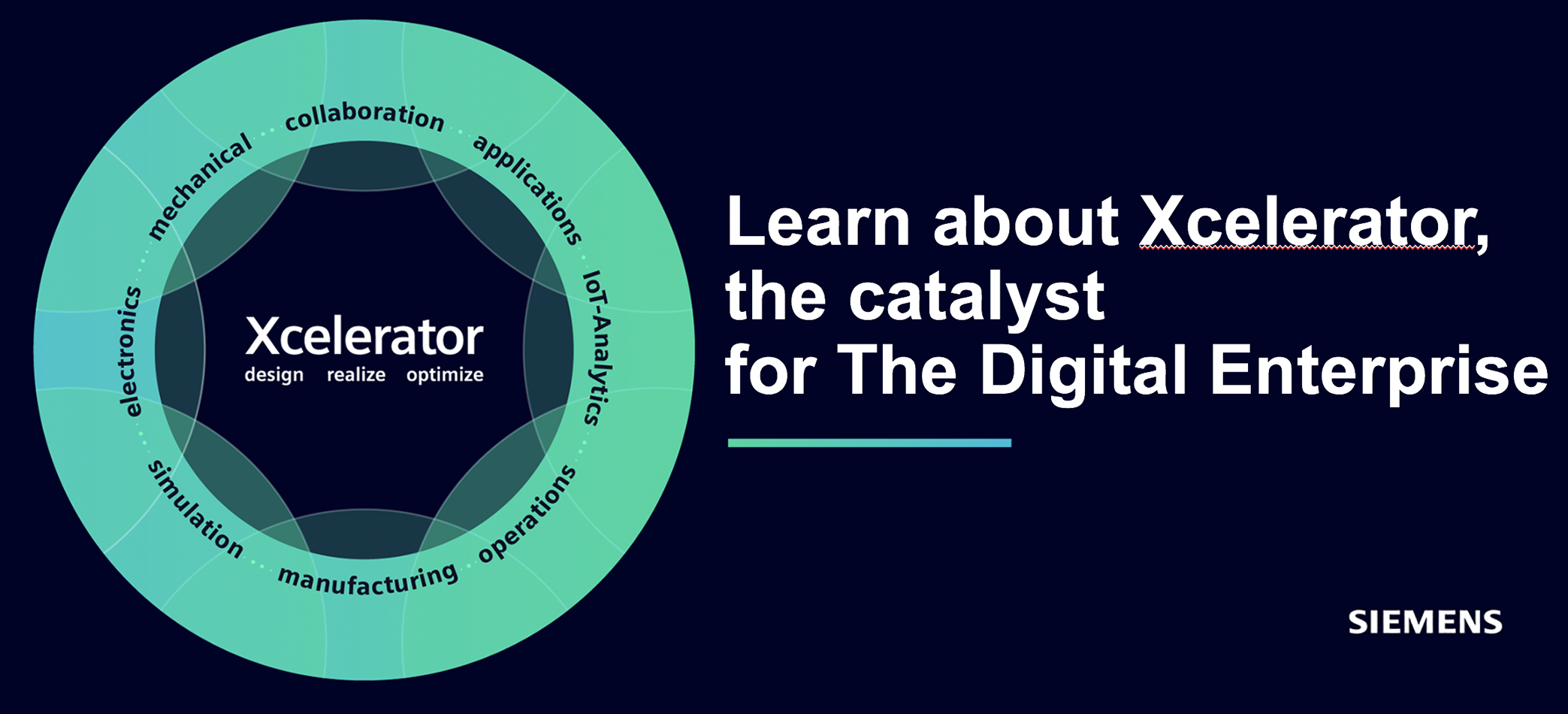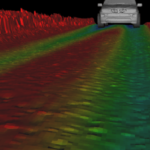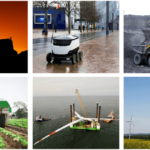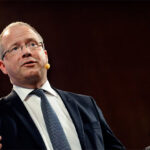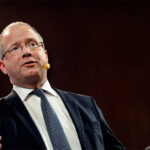LIVE CAD in the Industrial Metaverse: Siemens and Sony Man the Immersive Barricade
HANDS-ON THE NEW TECHNOLOGY on JANUARY 23 in STOCKHOLM. Immersive design using Siemens NX CAD and a new specially developed head-mounted display from Japanese electronics giant Sony – could that be your next digital tool option? Don't miss the chance to try out what many observers believe will become a mainstay in not only product development and the industrial metaverse concept, but which will also have productive offshoots in both maintenance and marketing. At an event in central Stockholm on Thursday, January 23, at 10:30am at Scandic Continental, Siemens Digital Industries Software's Nordic operation and Sony will showcase this interesting technology.
The immersive solution that Siemens and Sony have now developed was shown during last week's gigantic electronics event CES 2025, in Las Vegas, where the companies' joint in-depth project were among the news that attracted the most interest. The constellation has developed a coherent solution where Siemens stands for design technology via the NX CAD platform, while Sony develops the new high-level head-mounted display technology.
Immersive CAD design work with the help of these displays is an area that is increasingly emerging. Being able to both literally and figuratively step into and review, manipulate, interact and collaborate on digital 3D models provides unimagined opportunities to develop completely new levels of innovative product solutions.
PLM&ERP News has previously reported on the case where Volvo Trucks managed to test immersive interaction in the development work of the all-electric Volvo truck, the VNR Electric. This involved a digital scale one-to-one model, including all of the vehicle's more than 12,000 parts, which was run in VR to validate new design, assembly and maintenance processes.
“But the new technology combo we have developed is not just for OEMs, but is equally useful for smaller players. Today, it is not only an important future design track, but is a technology that has already received such good solution platforms that they will play important roles when the industrial metaverse now takes off,” sums up Siemens Digital Industries Software’s Nordic manager, Mats Friberg.
Among the leading developers, Siemens has advanced to one of the leading positions in recent years, not least based on the deep collaboration with its partner on the display side, Sony. The XR HMD (SRH-S1) has Sony’s high-resolution 1.3-type OLED micro-displays with 4K resolution, and a proprietary rendering technology for real-time, high-resolution and realistic rendering of 3D objects.
“Together with the Siemens Immersive Engineering toolkit, the development brings the power of ‘mixed reality’ to product development,” says Siemens CAD manager, senior VP, Bob Haubrock.
Click on the headline to read the full article on PLM&ERP News.
The immersive solution that Siemens and Sony have now developed was shown during last week's gigantic electronics event CES 2025, in Las Vegas, where the companies' joint in-depth project were among the news that attracted the most interest. The constellation has developed a coherent solution where Siemens stands for design technology via the NX CAD platform, while Sony develops the new high-level head-mounted display technology.
Immersive CAD design work with the help of these displays is an area that is increasingly emerging. Being able to both literally and figuratively step into and review, manipulate, interact and collaborate on digital 3D models provides unimagined opportunities to develop completely new levels of innovative product solutions.
PLM&ERP News has previously reported on the case where Volvo Trucks managed to test immersive interaction in the development work of the all-electric Volvo truck, the VNR Electric. This involved a digital scale one-to-one model, including all of the vehicle's more than 12,000 parts, which was run in VR to validate new design, assembly and maintenance processes.
“But the new technology combo we have developed is not just for OEMs, but is equally useful for smaller players. Today, it is not only an important future design track, but is a technology that has already received such good solution platforms that they will play important roles when the industrial metaverse now takes off,” sums up Siemens Digital Industries Software’s Nordic manager, Mats Friberg.
Among the leading developers, Siemens has advanced to one of the leading positions in recent years, not least based on the deep collaboration with its partner on the display side, Sony. The XR HMD (SRH-S1) has Sony’s high-resolution 1.3-type OLED micro-displays with 4K resolution, and a proprietary rendering technology for real-time, high-resolution and realistic rendering of 3D objects.
“Together with the Siemens Immersive Engineering toolkit, the development brings the power of ‘mixed reality’ to product development,” says Siemens CAD manager, senior VP, Bob Haubrock.
Click on the headline to read the full article on PLM&ERP News.
LIVE CAD i det industriella metaverset: Siemens och Sony kliver upp på den IMMERSIVA...
PROVA PÅ på den NYA TEKNIKEN den 23/1. Immersiv, eller omslutande design med hjälp av ett CAD-program, Siemens NX, och en ny spelcialutvecklad huvudmonterad display från elektronikjätten Sony – kan det vara något? Missa inte chansen att prova på det som bedömare menar blir en grundpelare inom produktutvecklingen och det industriella metaverse-konceptet, men som också får avläggare inom både underhåll och marknadsföring. På ett event i Stockholm torsdagen den 23 januari, kl 10.30, på Scandic Continental, kommer Siemens Digital Industries Software Norden och Sony att visa upp denna intressanta teknologi.
Den immersiva lösning som Siemens och Sony nu tagit fram står ut i teknologiskt hänseende. Något som inte minst visades under förra veckans gigantiska elektronikevent CES 2025, i Las Vegas, där bolagens nya immersiva projekt var bland det som väckte mest intresse. Konstellationen har utvecklat en sammanhållen lösning där Siemens står för designteknologin via NX CAD-plattformen, medan Sony utvecklat de huvudmonterade displayerna.
Immersivt designarbete med hjälp av denna display-typ är ett område som kommer allt mer. Att kunna kliva in i och granska, manipulera, interagera och samarbeta kring 3D-modeller live ger oanade möjligheter att utveckla helt nya nivåer av innovativa produkter. PLM&ERP News har tidigare rapporterat om caset där Volvo Trucks framgångsrikt testat immersiv interaktion i utvecklingsarbetet av den helelektriska Volvo-lastbilen, VNR Electric. Det handlade här om en digital skala ett-till-ett-modell, inkluderat alla fordonets mer än 12 000 delar, som kördes i VR för att validera nya design-, monterings- och underhållsprocesser.
”Men teknologin som vi nu har tagit fram är inte bara något för OEM-bolag, utan är lika användbar för mindre aktörer. Det är idag inte bara ett viktigt framtida designspår, utan är en teknologi som redan nu fått så bra lösningsplattformar att de kommer att spela tunga roller när den industriella metaversen nu tar fart,” summerar Siemens Digital Industries Softwares nordiske chef, Mats Friberg.
Bland spetsutvecklarna har Siemens under de senaste åren avancerat upp i en av de ledande positionerna, inte minst då baserat på det djupa samarbetet med partnern på displaysidan, Sony. XR HMD (SRH-S1) har Sonys högupplösta 1.3-typ OLED-mikroskärmar med 4K-upplösning, och en egenutvecklad renderingsteknik för realtid, högupplöst och realistisk rendering av 3D-objekt.
”Tillsammans med Siemens Immersive Engineering-verktygsuppsättning tillförs utvecklare kraften i ’mixed reality’ i produktutvecklingen,” säger Siemens CAD-chef, seniora VPn, Bob Haubrock.
Klicka på rubriken för att läsa mer på PLM&ERP News.
Den immersiva lösning som Siemens och Sony nu tagit fram står ut i teknologiskt hänseende. Något som inte minst visades under förra veckans gigantiska elektronikevent CES 2025, i Las Vegas, där bolagens nya immersiva projekt var bland det som väckte mest intresse. Konstellationen har utvecklat en sammanhållen lösning där Siemens står för designteknologin via NX CAD-plattformen, medan Sony utvecklat de huvudmonterade displayerna.
Immersivt designarbete med hjälp av denna display-typ är ett område som kommer allt mer. Att kunna kliva in i och granska, manipulera, interagera och samarbeta kring 3D-modeller live ger oanade möjligheter att utveckla helt nya nivåer av innovativa produkter. PLM&ERP News har tidigare rapporterat om caset där Volvo Trucks framgångsrikt testat immersiv interaktion i utvecklingsarbetet av den helelektriska Volvo-lastbilen, VNR Electric. Det handlade här om en digital skala ett-till-ett-modell, inkluderat alla fordonets mer än 12 000 delar, som kördes i VR för att validera nya design-, monterings- och underhållsprocesser.
”Men teknologin som vi nu har tagit fram är inte bara något för OEM-bolag, utan är lika användbar för mindre aktörer. Det är idag inte bara ett viktigt framtida designspår, utan är en teknologi som redan nu fått så bra lösningsplattformar att de kommer att spela tunga roller när den industriella metaversen nu tar fart,” summerar Siemens Digital Industries Softwares nordiske chef, Mats Friberg.
Bland spetsutvecklarna har Siemens under de senaste åren avancerat upp i en av de ledande positionerna, inte minst då baserat på det djupa samarbetet med partnern på displaysidan, Sony. XR HMD (SRH-S1) har Sonys högupplösta 1.3-typ OLED-mikroskärmar med 4K-upplösning, och en egenutvecklad renderingsteknik för realtid, högupplöst och realistisk rendering av 3D-objekt.
”Tillsammans med Siemens Immersive Engineering-verktygsuppsättning tillförs utvecklare kraften i ’mixed reality’ i produktutvecklingen,” säger Siemens CAD-chef, seniora VPn, Bob Haubrock.
Klicka på rubriken för att läsa mer på PLM&ERP News.
AI boostar efterfrågan på datacenter och sätter press på behoven av energi och effektiv...
Så kan datacenters kylteknik minska vattenstress: anpassning efter platsens ekologiska förutsättningar. Efterfrågan på datacenter ökar kraftigt, inte minst på grund av AI-utvecklingen. Enligt Goldman Sachs Research förväntas energianvändningen i datacenter öka med 160 procent fram till 2030. Tillväxten innebär att datacenter måste hantera både en ökande energianvändning och ett behov av effektiv kylning.
”Ett välplanerat kylsystem är avgörande för att säkerställa både energieffektivitet och hållbarhet. Men också vattenanvändningen måste vägas in, särskilt i områden där vattenbrist redan är ett problem,” säger Alex Setmajer, hållbarhetschef för ekologi på Equinix.
Sveriges datacenter står inför nya utmaningar i takt med att klimatförändringarna gör vatten till en alltmer begränsad resurs vilket förklarar vikten av att våra datacenter investerar i vattenfria kyltekniker för att möta framtidens behov och krav.
“Med ökande lokal vattenstress måste vi tänka om hur vi designar och driver datacenter”, säger Alex Setmajer.
Vattenstress är ett bredare begrepp än vattenbrist och inkluderar tillgången till vatten i ett område samt faktorer som vattenkvalitet och tillgänglighet. I områden där vatten är en begränsad resurs kan valet av industriella kylsystem vara avgörande för att minimera påverkan på lokalsamhället. Valet av kylteknik påverkar datacentrens totala resursanvändning. Alex Setmajer förklarar att de vanligaste metoderna – luftkylning och ångkylning – har olika fördelar och nackdelar beroende på de lokala förutsättningarna.
”Ångkylning är energieffektivt men kräver stora mängder vatten, vilket kan skapa problem i områden med vattenstress. Luftkylning är ett bra alternativ där vatten är en begränsad resurs. Denna kylteknik leder dock till högre energiförbrukning,” förklarar Equinix hållbarhetschef och pekar i dagens artikel på potentialen som finns i geotermisk kylning och värmeåtervinning.
Klicka på rubriken för att läsa mer på PLM&ERP New.
”Ett välplanerat kylsystem är avgörande för att säkerställa både energieffektivitet och hållbarhet. Men också vattenanvändningen måste vägas in, särskilt i områden där vattenbrist redan är ett problem,” säger Alex Setmajer, hållbarhetschef för ekologi på Equinix.
Sveriges datacenter står inför nya utmaningar i takt med att klimatförändringarna gör vatten till en alltmer begränsad resurs vilket förklarar vikten av att våra datacenter investerar i vattenfria kyltekniker för att möta framtidens behov och krav.
“Med ökande lokal vattenstress måste vi tänka om hur vi designar och driver datacenter”, säger Alex Setmajer.
Vattenstress är ett bredare begrepp än vattenbrist och inkluderar tillgången till vatten i ett område samt faktorer som vattenkvalitet och tillgänglighet. I områden där vatten är en begränsad resurs kan valet av industriella kylsystem vara avgörande för att minimera påverkan på lokalsamhället. Valet av kylteknik påverkar datacentrens totala resursanvändning. Alex Setmajer förklarar att de vanligaste metoderna – luftkylning och ångkylning – har olika fördelar och nackdelar beroende på de lokala förutsättningarna.
”Ångkylning är energieffektivt men kräver stora mängder vatten, vilket kan skapa problem i områden med vattenstress. Luftkylning är ett bra alternativ där vatten är en begränsad resurs. Denna kylteknik leder dock till högre energiförbrukning,” förklarar Equinix hållbarhetschef och pekar i dagens artikel på potentialen som finns i geotermisk kylning och värmeåtervinning.
Klicka på rubriken för att läsa mer på PLM&ERP New.
HEXAGON acquires company with groundbreaking positioning solution for navigation and autonomous applications
RELIABLE POSITIONING, down to the CENTIMETER LEVEL in everything from AUTOMOTIVE and UAVs to CONSTRUCTION and LOGISTICS. Hexagon, a Swedish industry group that supplies measurement and positioning systems for objects in both the micro and macro segments, announces the acquisition of the Belgian company Septentrio NV. The latter is a market leader and OEM provider of technologies for global navigation satellite systems, Global Navigation Satellite System (GNSS), to drive innovation and expand the market reach of Resilient Assured Positioning solutions. More specifically, Septentrio designs, manufactures and sells high-precision multi-frequency and constellation GNSS receivers for use in demanding applications.
”The company's receivers deliver accurate and reliable positioning, down to the centimeter level,” says,” Norbert Hanke, interim CEO of Hexagon.
Currently, GNSS/GPS is used in a variety of areas where the use of accurate, constantly available position and time information is required. Reliable centimeter-level positioning enables, for example, machine automation that improves efficiency and safety. In this, Septentrio provides solutions for industrial applications such as robotics, construction, mapping and surveying, maritime, logistics and unmanned aerial vehicles (UAV). In terms of industry, it is found in agriculture, transportation, machine control, marine navigation, vehicle navigation, mobile communications and, interestingly, also athletics.
By combining Septentrio's GNSS platform with Hexagon's extensive positioning portfolio, including sensor fusion, anti-jamming, correction services and perception technologies, Hexagon believes that, "it will enable groundbreaking solutions for various markets and applications that ensure greater accessibility to high-precision and high-performance positioning technology with low SWaP (Size, Weight and Power) characteristics. ”
Norbert Hanke, claims that today’s announced acquisition will accelerate the adoption of autonomous systems in existing markets and meet the needs of emerging high-growth segments such as robotics, UAVs, autonomy and other mission-critical applications.
“The combination of Hexagon and Septentrio will transform the positioning industry across existing and new markets and set new standards for the accuracy, resilience and scalability of positioning technologies, necessary to support and accelerate the journey towards full autonomy,” he says in a comment.
Examples of Septentrio customers are Swedish defense giant Saab Group and Xenomatix, an established tier II automotive supplier providing LiDAR based solutions enabling autonomous driving.
How will the now announced purchase strengthen Hexagon? Click on the headline to read the full story on PLM&ERP News.
”The company's receivers deliver accurate and reliable positioning, down to the centimeter level,” says,” Norbert Hanke, interim CEO of Hexagon.
Currently, GNSS/GPS is used in a variety of areas where the use of accurate, constantly available position and time information is required. Reliable centimeter-level positioning enables, for example, machine automation that improves efficiency and safety. In this, Septentrio provides solutions for industrial applications such as robotics, construction, mapping and surveying, maritime, logistics and unmanned aerial vehicles (UAV). In terms of industry, it is found in agriculture, transportation, machine control, marine navigation, vehicle navigation, mobile communications and, interestingly, also athletics.
By combining Septentrio's GNSS platform with Hexagon's extensive positioning portfolio, including sensor fusion, anti-jamming, correction services and perception technologies, Hexagon believes that, "it will enable groundbreaking solutions for various markets and applications that ensure greater accessibility to high-precision and high-performance positioning technology with low SWaP (Size, Weight and Power) characteristics. ”
Norbert Hanke, claims that today’s announced acquisition will accelerate the adoption of autonomous systems in existing markets and meet the needs of emerging high-growth segments such as robotics, UAVs, autonomy and other mission-critical applications.
“The combination of Hexagon and Septentrio will transform the positioning industry across existing and new markets and set new standards for the accuracy, resilience and scalability of positioning technologies, necessary to support and accelerate the journey towards full autonomy,” he says in a comment.
Examples of Septentrio customers are Swedish defense giant Saab Group and Xenomatix, an established tier II automotive supplier providing LiDAR based solutions enabling autonomous driving.
How will the now announced purchase strengthen Hexagon? Click on the headline to read the full story on PLM&ERP News.
HEXAGON köper bolag med banbrytande lösning för positionering inom navigering och för autonoma applikationer
EXAKT och PÅLITLIG POSITIONERING, ner PÅ CENTIMETERNIVÅ. Hexagon meddelar att man köper det belgiska bolaget Septentrio NV, en marknadsledare och OEM-leverantör av teknologier för globala satellitbaserade navigations-system, Global Navigation Satellite System (GNSS), för att driva innovation och utöka marknadsräckvidden för Resilient Assured Positioning-lösningar.
Mer detaljerat designar, tillverkar och säljer Septentrio högprecisions multi-frekvens och -konstellations GNSS-mottagare för användning i krävande applikationer. Bolagets mottagare levererar exakt och pålitlig positionering, t o m ner på centimeternivå.
För närvarande används GNSS/GPS inom en mängd olika områden där användningen av exakt, ständigt tillgänglig positions- och tidsinformation krävs. Pålitlig positionering på centimeternivå möjliggör t ex maskinautomatisering som förbättrar effektivitet och säkerhet. I detta tillhandahåller Septentrio positioneringslösningar för industriella tillämpningar som robotik, konstruktion, kartläggning och kartläggning, sjöfart, logistik och obemannade flygfarkoster (UAV). Branschmässig finns man inom jordbruk, transport, maskinkontroll, marin navigation, fordonsnavigering, mobil kommunikation och intressant nog också friidrott.
Genom att kombinera Septentrios GNSS-plattform med Hexagons omfattande positioneringsportfölj, inklusive sensorfusion, anti-jamming, korrigeringstjänster och perceptionsteknologier, menar Hexagon att man, ”kommer det att möjliggöra banbrytande lösningar för olika marknader och applikationer som säkerställer större tillgänglighet till hög precision och högpresterande positioneringsteknik med låga SWaP-egenskaper (Size, Weight and Power).”
Interims-CEOn för Hexagon, Norbert Hanke, hävdar att dagens annonserade förvärv kommer att påskynda införandet av autonoma system på befintliga marknader och tillgodose behoven hos framväxande högtillväxtsegment som robotik, UAV, autonomi och andra verksamhetskritiska applikationer.
"Kombinationen av Hexagon och Septentrio kommer att omvandla positioneringsindustrin över befintliga och nya marknader och sätta nya standarder för noggrannhet, motståndskraft och skalbarhet hos positioneringsteknologier, nödvändiga för att stödja och påskynda resan mot full autonomi", säger han i en kommentar.
Hur kan det nu annonserade köpet stärka Hexagon? Klicka på rubriken för att läsa mer på PLM&ERP News.
Mer detaljerat designar, tillverkar och säljer Septentrio högprecisions multi-frekvens och -konstellations GNSS-mottagare för användning i krävande applikationer. Bolagets mottagare levererar exakt och pålitlig positionering, t o m ner på centimeternivå.
För närvarande används GNSS/GPS inom en mängd olika områden där användningen av exakt, ständigt tillgänglig positions- och tidsinformation krävs. Pålitlig positionering på centimeternivå möjliggör t ex maskinautomatisering som förbättrar effektivitet och säkerhet. I detta tillhandahåller Septentrio positioneringslösningar för industriella tillämpningar som robotik, konstruktion, kartläggning och kartläggning, sjöfart, logistik och obemannade flygfarkoster (UAV). Branschmässig finns man inom jordbruk, transport, maskinkontroll, marin navigation, fordonsnavigering, mobil kommunikation och intressant nog också friidrott.
Genom att kombinera Septentrios GNSS-plattform med Hexagons omfattande positioneringsportfölj, inklusive sensorfusion, anti-jamming, korrigeringstjänster och perceptionsteknologier, menar Hexagon att man, ”kommer det att möjliggöra banbrytande lösningar för olika marknader och applikationer som säkerställer större tillgänglighet till hög precision och högpresterande positioneringsteknik med låga SWaP-egenskaper (Size, Weight and Power).”
Interims-CEOn för Hexagon, Norbert Hanke, hävdar att dagens annonserade förvärv kommer att påskynda införandet av autonoma system på befintliga marknader och tillgodose behoven hos framväxande högtillväxtsegment som robotik, UAV, autonomi och andra verksamhetskritiska applikationer.
"Kombinationen av Hexagon och Septentrio kommer att omvandla positioneringsindustrin över befintliga och nya marknader och sätta nya standarder för noggrannhet, motståndskraft och skalbarhet hos positioneringsteknologier, nödvändiga för att stödja och påskynda resan mot full autonomi", säger han i en kommentar.
Hur kan det nu annonserade köpet stärka Hexagon? Klicka på rubriken för att läsa mer på PLM&ERP News.
Volvo Group’s Chief Puts His Foot Down at CES in Las Vegas: ”The Time...
AUTOMOTIVE/CES 2025 in LAS VEGAS/SUSTAINABILITY. When Volvo Group’s CEO Martin Lundstedt speaks today at one of the world's leading technology events, the electronics trade show CES in Las Vegas, the theme is serious but concise: "We are here in Las Vegas today to deliver a simple but urgent message: The time for talk is over. The time for action is now," he says.
Lundstedt is on hand to explain how one of the world's leading truck manufacturer views sustainability in general and decarbonization in particular.
"We have a holistic view of the decarbonization of the transport, mobility and infrastructure industry," says the Volvo boss and he urges both political decision-makers and industry leaders to accelerate the transition to zero-emission vehicles (ZEV).
"Given the challenges the world faces due to climate change, it is time to reshape the transport system for the next 100 years. Without transport, mobility and infrastructure solutions, modern life would come to a standstill. So much of our world depends on getting goods to their destination, take people to work and build communities – but we have to do it much more sustainably,” he adds.
The development also speaks a language that supports Lundstedt’s view of the development of the transport industry. With freight volumes set to increase fivefold by 2050, the transition to ZEV solutions has become a necessity. The good news is that these solutions are already available and are in continuous development, as the Volvo Group’s demonstration of advanced battery electric solutions, hydrogen fuel cell technology and renewable fuel shows.
A weighty point in Lundstedt’s reasoning is that the transition to a more efficient and cleaner transport system depends on far more than just the players in the automotive sector: among other things, it also depends on the actions of decision-makers, government and industrial leaders. Cooperation and insight into the seriousness of the situation are necessary.
“Policymakers need to accelerate the uptake of ZEV transport and infrastructure solutions. We need clean energy generation, reliable charging infrastructure and effective incentives to accelerate adoption. This transformation is not about switching to a single new product or technology – it is about accelerating a paradigm shift – and we cannot do it alone. The time for talk is over. We need to get this show going, and we need to start now,” says Martin Lundstedt, whose company on the PLM side basically works in PTC environments with Creo CAD on the design side and Windchill for PLM/PDM.
What possibly underpins the frustration of the Volvo base when it comes to electric trucks is that sales both locally and globally are still very small. In 2023, this will be a share of just 1 percent for heavy vehicles. But in this arena, the Volvo Group is the clear market leader.
Click on the headline to read more on PLM&ERP News.
Lundstedt is on hand to explain how one of the world's leading truck manufacturer views sustainability in general and decarbonization in particular.
"We have a holistic view of the decarbonization of the transport, mobility and infrastructure industry," says the Volvo boss and he urges both political decision-makers and industry leaders to accelerate the transition to zero-emission vehicles (ZEV).
"Given the challenges the world faces due to climate change, it is time to reshape the transport system for the next 100 years. Without transport, mobility and infrastructure solutions, modern life would come to a standstill. So much of our world depends on getting goods to their destination, take people to work and build communities – but we have to do it much more sustainably,” he adds.
The development also speaks a language that supports Lundstedt’s view of the development of the transport industry. With freight volumes set to increase fivefold by 2050, the transition to ZEV solutions has become a necessity. The good news is that these solutions are already available and are in continuous development, as the Volvo Group’s demonstration of advanced battery electric solutions, hydrogen fuel cell technology and renewable fuel shows.
A weighty point in Lundstedt’s reasoning is that the transition to a more efficient and cleaner transport system depends on far more than just the players in the automotive sector: among other things, it also depends on the actions of decision-makers, government and industrial leaders. Cooperation and insight into the seriousness of the situation are necessary.
“Policymakers need to accelerate the uptake of ZEV transport and infrastructure solutions. We need clean energy generation, reliable charging infrastructure and effective incentives to accelerate adoption. This transformation is not about switching to a single new product or technology – it is about accelerating a paradigm shift – and we cannot do it alone. The time for talk is over. We need to get this show going, and we need to start now,” says Martin Lundstedt, whose company on the PLM side basically works in PTC environments with Creo CAD on the design side and Windchill for PLM/PDM.
What possibly underpins the frustration of the Volvo base when it comes to electric trucks is that sales both locally and globally are still very small. In 2023, this will be a share of just 1 percent for heavy vehicles. But in this arena, the Volvo Group is the clear market leader.
Click on the headline to read more on PLM&ERP News.
Volvochefen Martin Lundstedt ryter ifrån på världens ledande teknikmässa: ”Tiden för prat är över,...
AUTOMOTIVE/CES 2025 i LAS VEGAS/HÅLLBARHET. När Volvo Groups koncernchef, Martin Lundstedt, idag tar till orda på ett av världens ledande teknologi-event, den stora elektronikmässan CES i Las Vegas, är temat alvarsamt men koncist:
"Vi är här i Las Vegas idag för att leverera ett enkelt men brådskande budskap: Tiden för samtal är över. Det är dags att agera nu, säger han.
Lundstedt är på plats för att berätta om hur den världledande lastbils- och busstillverkaren ser på hållbarhetsbitarna i allmänhet och avkolningen i synnerhet.
”Vi har en holistisk grundsyn avkarboniseringen av transport-, mobilitets- och infrastrukturindustrin, säger Volvo-basen i ett tal där han uppmanar såväl politiska beslutsfattare som industriledare att påskynda övergången till nollutsläppsfordon (ZEV).
”Med tanke på de utmaningar världen står inför på grund av klimatförändringarna är det dags att ombilda transportsystemet för de kommande 100 åren. Utan transport-, mobilitets- och infrastrukturlösningar skulle det moderna livet stå still. Så mycket av vår värld är beroende av att få varor till sin destination, ta människor till jobbet och bygga samhällen – men vi måste göra det betydligt mer hållbart”, tillägger han.
Utvecklingen talar också ett språk som underbygger Lundstedts syn på transportindustrins utveckling. Med en femfaldig ökning av fraktvolymerna fram till 2050 har övergången till ZEV-lösningar blivit en klar nödvändighet. Den goda nyheten är att dessa lösningar redan är tillgängliga och är i kontinuerlig utveckling, vilket Volvokoncernens uppvisning av avancerade batterielektriska lösningar, vätebränslecells-teknik och förnybart bränsle visar.
En tung poäng i Lundstedts resonemang är att ingen enskild aktör kan lösa industrins utmaningar ensam. Övergången till ett effektivare och renare transportsystem beror på betydligt fler än bara fordonssektorns spelare: bland annat hänger utvecklingen på agerandet från beslutsfattare, statliga och industriella ledare. Samarbete och insikten om situationens allvar måste till.
"Policymakare måste påskynda upptaget av ZEV-transport- och infrastrukturlösningar. Vi behöver ren energiproduktion, pålitlig laddningsinfrastruktur och effektiva incitament för att påskynda adoptionen. Denna transformation handlar inte om att byta till en enskild ny produkt eller teknologi – det handlar om att påskynda ett paradigmskifte – och vi kan inte göra det ensamma. Tiden för samtal är förbi. Vi måste få den här showen på väg, och vi måste börja nu om vi vill forma den värld vi vill leva i,” säger Martin Lundstedt, vars bolag på PLM-sidan basalt jobbar i PTC-miljöer med Creo CAD på designsidan och Windchill när det gäller PLM/PDM.
Vad som möjligen underbygger Volvo-basens frustration när det gäller eldrivna lastbilar är att försäljningen både lokalt och globalt ännu är mycket liten. 2023 rör det sig om en andel på bara 1 procent för tunga fordon. Men på denna arena är Volvo Group hur som helst klar marknadsledare.
Klicka på rubriken för att läsa mer på PLM&ERP News.
Lundstedt är på plats för att berätta om hur den världledande lastbils- och busstillverkaren ser på hållbarhetsbitarna i allmänhet och avkolningen i synnerhet.
”Vi har en holistisk grundsyn avkarboniseringen av transport-, mobilitets- och infrastrukturindustrin, säger Volvo-basen i ett tal där han uppmanar såväl politiska beslutsfattare som industriledare att påskynda övergången till nollutsläppsfordon (ZEV).
”Med tanke på de utmaningar världen står inför på grund av klimatförändringarna är det dags att ombilda transportsystemet för de kommande 100 åren. Utan transport-, mobilitets- och infrastrukturlösningar skulle det moderna livet stå still. Så mycket av vår värld är beroende av att få varor till sin destination, ta människor till jobbet och bygga samhällen – men vi måste göra det betydligt mer hållbart”, tillägger han.
Utvecklingen talar också ett språk som underbygger Lundstedts syn på transportindustrins utveckling. Med en femfaldig ökning av fraktvolymerna fram till 2050 har övergången till ZEV-lösningar blivit en klar nödvändighet. Den goda nyheten är att dessa lösningar redan är tillgängliga och är i kontinuerlig utveckling, vilket Volvokoncernens uppvisning av avancerade batterielektriska lösningar, vätebränslecells-teknik och förnybart bränsle visar.
En tung poäng i Lundstedts resonemang är att ingen enskild aktör kan lösa industrins utmaningar ensam. Övergången till ett effektivare och renare transportsystem beror på betydligt fler än bara fordonssektorns spelare: bland annat hänger utvecklingen på agerandet från beslutsfattare, statliga och industriella ledare. Samarbete och insikten om situationens allvar måste till.
"Policymakare måste påskynda upptaget av ZEV-transport- och infrastrukturlösningar. Vi behöver ren energiproduktion, pålitlig laddningsinfrastruktur och effektiva incitament för att påskynda adoptionen. Denna transformation handlar inte om att byta till en enskild ny produkt eller teknologi – det handlar om att påskynda ett paradigmskifte – och vi kan inte göra det ensamma. Tiden för samtal är förbi. Vi måste få den här showen på väg, och vi måste börja nu om vi vill forma den värld vi vill leva i,” säger Martin Lundstedt, vars bolag på PLM-sidan basalt jobbar i PTC-miljöer med Creo CAD på designsidan och Windchill när det gäller PLM/PDM.
Vad som möjligen underbygger Volvo-basens frustration när det gäller eldrivna lastbilar är att försäljningen både lokalt och globalt ännu är mycket liten. 2023 rör det sig om en andel på bara 1 procent för tunga fordon. Men på denna arena är Volvo Group hur som helst klar marknadsledare.
Klicka på rubriken för att läsa mer på PLM&ERP News.
Blazing the Trail in CES 2025: Siemens is on the Move with New Industrial...
“WHAT HAPPENS IN LAS VEGAS doesn’t necessarily stay in Las Vegas – CES 2025 is the proof…” An early sign of spring in PLM and cutting-edge technology development is the CES tech trade show in Las Vegas. When it started today, Siemens was one of the most visible actors among the major PLM players. Several big things are poster pillars for the company, but not surprisingly, AI is the area most heavily promoted. The company’s CTO and Chief Strategy Officer, Peter Koerte, spoke, among other things, about a vision for the future where data, AI and software-defined automation will converge to, “enable unprecedented flexibility, optimization and continuous improvement across the world’s industries, for companies of all sizes.” Big ambitions of course, but also a message at the heart of Siemens’ presence at CES 2025, one of the world’s most influential technology events. Siemens is, Koerte noted, a global leader in industrial software and pointed to the fact that it is now taking bold new steps in industrial innovation.
“Industrial AI is a game changer that will create significant positive impacts in the real world across all industries,” he said and adden: “It allows us to harness the enormous amounts of data generated in industrial environments and transform them into insights that drive businesses. We are adding new AI capabilities across the entire Siemens Xcelerator portfolio to enable our customers to remain competitive, resilient and sustainable in an increasingly complex world.”
Among the pieces he specifically noted was that it is now bringing AI directly to the shop floor with the new “Industrial Copilot for Operations” solution. Among several benefits is that AI tasks can be run as close to machines as possible via edge computing. This facilitates rapid, real-time decision-making for operators and maintenance engineers, increasing productivity and minimizing downtime.
The Industrial Copilot ecosystem is continuously evolving to offer AI capabilities across the entire industrial value chain and to sectors including discrete and process manufacturing, infrastructure and mobility. This suite of copilots can improve human-machine collaboration across all experience levels, helping to accelerate development times and innovation cycles. Siemens Industrial Copilot will integrate with the Industrial Edge ecosystem, which has been enhanced with AI to deploy, operate and manage AI models within the production environment.
But there was more on the menu; such as Siemens' NVIDIA collaboration to deliver physically based visualization for product lifecycle management, an exciting customer collaboration with startup JetZero on an aircraft solution that paves the way towards net-zero operation via partial hydrogen propulsion, and the collaboration with Sony, which was already announced at CES last year, where the companies are now delivering immersive design opportunities with mixed-reality headsets and NX CAD software in combo.
Click on the title to read the full report on Siemens at CES 2025.
“Industrial AI is a game changer that will create significant positive impacts in the real world across all industries,” he said and adden: “It allows us to harness the enormous amounts of data generated in industrial environments and transform them into insights that drive businesses. We are adding new AI capabilities across the entire Siemens Xcelerator portfolio to enable our customers to remain competitive, resilient and sustainable in an increasingly complex world.”
Among the pieces he specifically noted was that it is now bringing AI directly to the shop floor with the new “Industrial Copilot for Operations” solution. Among several benefits is that AI tasks can be run as close to machines as possible via edge computing. This facilitates rapid, real-time decision-making for operators and maintenance engineers, increasing productivity and minimizing downtime.
The Industrial Copilot ecosystem is continuously evolving to offer AI capabilities across the entire industrial value chain and to sectors including discrete and process manufacturing, infrastructure and mobility. This suite of copilots can improve human-machine collaboration across all experience levels, helping to accelerate development times and innovation cycles. Siemens Industrial Copilot will integrate with the Industrial Edge ecosystem, which has been enhanced with AI to deploy, operate and manage AI models within the production environment.
But there was more on the menu; such as Siemens' NVIDIA collaboration to deliver physically based visualization for product lifecycle management, an exciting customer collaboration with startup JetZero on an aircraft solution that paves the way towards net-zero operation via partial hydrogen propulsion, and the collaboration with Sony, which was already announced at CES last year, where the companies are now delivering immersive design opportunities with mixed-reality headsets and NX CAD software in combo.
Click on the title to read the full report on Siemens at CES 2025.
Siemens på hugget under CES 2025: Innovationer inom industriell AI och digital tvillingar väcker...
”DET SOM HÄNDER I LAS VEGAS stannar inte nödvändigtvis i Las Vegas – det är CES 2025 beviset på…” Ett tidigt tecken på att vårsäsongen inom PLM, automation och allmänt när det gäller vass teknologiutveckling är den stora CES-mässan i Las Vegas, där alla med stora teknologi-ambitioner vill synas. När det startade idag, den 7 januari var Siemens en av de mest synliga aktörerna bland de stora PLM-spelarna. Flera saker stora saker är affischpelare för denna ledande PLM- och automationsspelare. Men inte överraskande är AI ett av de området man slår på trumman för. Bolagets styrelsemedlem, CTO och strategichef, Peter Koerte, berättade bl a om en vision för framtiden där data, AI och mjukvarudefinierad automation kommer att konvergera för att, ”möjliggöra oöverträffad flexibilitet, optimering och ständiga förbättringar över världens industrier, för företag av alla storlekar.” Stora ambitioner förstås och kärnan i Siemens närvaro vid CES 2025, ett av världens mest inflytelserika teknikevenemang. Siemens är, konstaterade Koerte inte utan goda anledningar, en global ledaren inom industriell mjukvara och pekade på att man nu tar än mer djärva steg i industriell innovation.
"Industriell AI är en spelomvandlare som kommer att skapa betydande positiva effekter i den verkliga världen inom alla branscher. Industriell AI låter oss utnyttja de enorma mängderna data som genereras i industriella miljöer och omvandla den till insikter som driver verklig affärseffekt. Vi lägger till nya industriella AI-kapaciteter i hela Siemens Xcelerator-portfölj för att göra det möjligt för våra kunder att förbli konkurrenskraftiga, motståndskraftiga och hållbara i en allt mer komplex värld", sa han.
Bland de bitar han specifikt noterade var att man nu tar Industrial AI direkt till verkstadsgolvet med den nya ”Industrial Copilot for Operations-lösningen”. Bland flera fördelar är att AI-uppgifter kan köras så nära maskiner som möjligt, via ”edge computing.” Detta underlättar snabbt beslutsfattande i realtid för operatörer och underhållsingenjörer, vilket ökar produktiviteten och minimerar stilleståndstiden. Industrial Copilots ekosystem utvecklas kontinuerligt för att erbjuda AI-kapacitet över hela den industriella värdekedjan och till sektorer som inkluderar diskret och processtillverkning, infrastruktur och mobilitet. Denna svit av copiloter kan förbättra samarbete mellan människa och maskin över alla erfarenhetsnivåer, vilket hjälper till att påskynda utvecklingstider och innovationscykler. Siemens Industrial Copilot kommer att integreras med Industrial Edge-ekosystemet, som har förbättrats med AI för att distribuera, driva och hantera AI-modeller inom produktionsmiljön.
Men här fanns mer på menyn; som Siemens NVIDIA-samarbete för att leverera fysiskt baserad visualisering för produktlivscykel-hantering, ett spännande kundsamarbete med startupen JetZero kring en flygplanslösning som banar väg mot netto-noll-drift via partitiell vätedrift, och samarbetet med Sony, som annonserades redan på CES ifjol, där bolagen nu levererar immersiva design-möjligheter med mixed-reality-headset och NX CAD-programvara i kombo.
Klicka på rubriken för att läsa hela reportaget kring Siemens på CES 2025.
"Industriell AI är en spelomvandlare som kommer att skapa betydande positiva effekter i den verkliga världen inom alla branscher. Industriell AI låter oss utnyttja de enorma mängderna data som genereras i industriella miljöer och omvandla den till insikter som driver verklig affärseffekt. Vi lägger till nya industriella AI-kapaciteter i hela Siemens Xcelerator-portfölj för att göra det möjligt för våra kunder att förbli konkurrenskraftiga, motståndskraftiga och hållbara i en allt mer komplex värld", sa han.
Bland de bitar han specifikt noterade var att man nu tar Industrial AI direkt till verkstadsgolvet med den nya ”Industrial Copilot for Operations-lösningen”. Bland flera fördelar är att AI-uppgifter kan köras så nära maskiner som möjligt, via ”edge computing.” Detta underlättar snabbt beslutsfattande i realtid för operatörer och underhållsingenjörer, vilket ökar produktiviteten och minimerar stilleståndstiden. Industrial Copilots ekosystem utvecklas kontinuerligt för att erbjuda AI-kapacitet över hela den industriella värdekedjan och till sektorer som inkluderar diskret och processtillverkning, infrastruktur och mobilitet. Denna svit av copiloter kan förbättra samarbete mellan människa och maskin över alla erfarenhetsnivåer, vilket hjälper till att påskynda utvecklingstider och innovationscykler. Siemens Industrial Copilot kommer att integreras med Industrial Edge-ekosystemet, som har förbättrats med AI för att distribuera, driva och hantera AI-modeller inom produktionsmiljön.
Men här fanns mer på menyn; som Siemens NVIDIA-samarbete för att leverera fysiskt baserad visualisering för produktlivscykel-hantering, ett spännande kundsamarbete med startupen JetZero kring en flygplanslösning som banar väg mot netto-noll-drift via partitiell vätedrift, och samarbetet med Sony, som annonserades redan på CES ifjol, där bolagen nu levererar immersiva design-möjligheter med mixed-reality-headset och NX CAD-programvara i kombo.
Klicka på rubriken för att läsa hela reportaget kring Siemens på CES 2025.
Siemens lanserar nytt program för att vässa nystartade företag med spetsteknologi
PLM- och CAx-mjukvara från XCELERATOR-portföljen en grundpelare i nytt startup-paket. Ett bra sätt att stödja innovativa startups med lovande teknologier är att i tidiga skeden erbjuda kvalificerade aktörer vassa, starkt rabatterade IT-lösningar, inte minst då när det gäller PLM-bitarna. Det som initialt kan handla om relativt små satsningar kan, om idéerna har genomslagskraft, växa till synnerligen stora installationer på med tiden normala kommersiella villkor. Detta har de flesta större PLM-utvecklarna i varierande omfattning tagit fasta på, men klart är att Siemens är en av de mest proaktiva spelarna på området.
När det stora konsument-elektronikeventet CES 2025 i Las Vegas startade idag (7 till 11 januari) passade bolaget på att lansera ett nytt sådant startup-program, ”Siemens for Stratups”. Programmet är särskilt intressant för nystartade rörelser inom konstruktion och tillverkning och går ut på att tillhandahålla lösningar för att effektivisera samarbetsprocesser och underlätta partnerskap med nya innovativa företag. Tillsammans med AWS, Amazon Web Services, Siemens kommer man att ge tillgång till Siemens Xcelerator ekosystem för att påskynda innovation för startups.
"Startups är avgörande för att göra våra kunder mer konkurrenskraftiga, hållbara och motståndskraftiga. Genom att samarbeta med startups hjälper Siemens till att föra banbrytande idéer till industrier snabbare, vilket ger kunderna möjlighet att hantera globala utmaningar mer effektivt med banbrytande teknologier, verktyg och lösningar", kommenterar Peter Koerte, styrelseledamot för Siemens AG, Chief Technology Officer och Chief Strategy Officer.
De som antas till programmet kommer att få tillgång till och kunna integrera Siemens omfattande svit av industriell mjukvara – inkluderat design-, simulerings- och tillverkningslösningar från Siemens Xcelerator-portföljen – inom ramen för AWS skalbara molninfrastruktur. På Xcelerator-plattformen finns bl a digitala spetsverktyg som NX CAD, simulerings- & analys-portföljen Simcenter och inte minst bolagets marknadsledande cPDm-mjukvara, Teamcenter. För teknisk support och go-to-market support kommer kvalificerade startups också att få AWS-krediter, affärsutvecklingsresurser och tillgång till AWS Activate-programmet.
Programmet har tre pelare:
• Hjälp att komma igång på Siemens Xcelerators marknadsplats.
• Siemens erbjuder också ett omfattande samarbete som ger startups tillgång till banbrytande kapacitet och tjänster som ger startups de tidiga intäkter som behövs för tillväxt.
• Och, som sagt, paketerad tillgång till viktiga mjukvaruverktyg från Siemens Xcelerator-portföljen.
Klicka på rubriken för att läsa mer på PLM&ERP News.
När det stora konsument-elektronikeventet CES 2025 i Las Vegas startade idag (7 till 11 januari) passade bolaget på att lansera ett nytt sådant startup-program, ”Siemens for Stratups”. Programmet är särskilt intressant för nystartade rörelser inom konstruktion och tillverkning och går ut på att tillhandahålla lösningar för att effektivisera samarbetsprocesser och underlätta partnerskap med nya innovativa företag. Tillsammans med AWS, Amazon Web Services, Siemens kommer man att ge tillgång till Siemens Xcelerator ekosystem för att påskynda innovation för startups.
"Startups är avgörande för att göra våra kunder mer konkurrenskraftiga, hållbara och motståndskraftiga. Genom att samarbeta med startups hjälper Siemens till att föra banbrytande idéer till industrier snabbare, vilket ger kunderna möjlighet att hantera globala utmaningar mer effektivt med banbrytande teknologier, verktyg och lösningar", kommenterar Peter Koerte, styrelseledamot för Siemens AG, Chief Technology Officer och Chief Strategy Officer.
De som antas till programmet kommer att få tillgång till och kunna integrera Siemens omfattande svit av industriell mjukvara – inkluderat design-, simulerings- och tillverkningslösningar från Siemens Xcelerator-portföljen – inom ramen för AWS skalbara molninfrastruktur. På Xcelerator-plattformen finns bl a digitala spetsverktyg som NX CAD, simulerings- & analys-portföljen Simcenter och inte minst bolagets marknadsledande cPDm-mjukvara, Teamcenter. För teknisk support och go-to-market support kommer kvalificerade startups också att få AWS-krediter, affärsutvecklingsresurser och tillgång till AWS Activate-programmet.
Programmet har tre pelare:
• Hjälp att komma igång på Siemens Xcelerators marknadsplats.
• Siemens erbjuder också ett omfattande samarbete som ger startups tillgång till banbrytande kapacitet och tjänster som ger startups de tidiga intäkter som behövs för tillväxt.
• Och, som sagt, paketerad tillgång till viktiga mjukvaruverktyg från Siemens Xcelerator-portföljen.
Klicka på rubriken för att läsa mer på PLM&ERP News.


